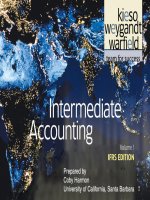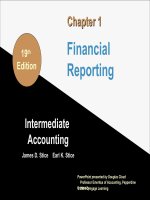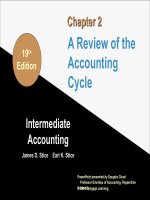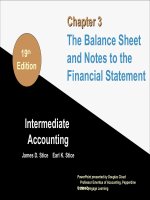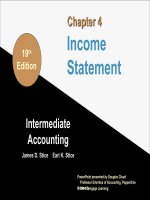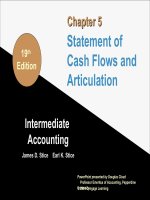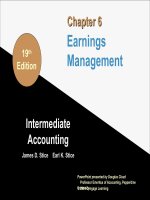Intermediate accounting 19th by stice stice chapter 12
Bạn đang xem bản rút gọn của tài liệu. Xem và tải ngay bản đầy đủ của tài liệu tại đây (224.16 KB, 87 trang )
Chapter 12
19th
Edition
Debt
Financing
Intermediate
Accounting
James D. Stice
Earl K. Stice
PowerPoint presented by Douglas Cloud
Professor Emeritus of Accounting, Pepperdine
University
© 2014 Cengage Learning
12-1
Definition of Liabilities
The FASB defined liabilities as “probable
future sacrifices of economic benefits
arising from present obligations to a
particular entity to transfer assets or
provide services to other entities in the
future as a result of past transactions or
events.”
The FASB is currently considering a
revision of this liability definition.
(continued)
12-2
Classification of Liabilities
•
For reporting purposes liabilities are
usually classified as current or noncurrent.
•
If a liability arises in the course of an
entity’s normal operating cycle, it is
considered current if current assets are
used to satisfy the obligation within one
year or one operating cycle, whichever
period is longer.
(continued)
12-3
Classification of Liabilities
•
The classification of a liability as current or
noncurrent can impact significantly a
company’s ability to raise additional funds.
•
When debt classified as noncurrent will
mature within the next year, the liability
should be reported as a current liability.
•
The distinction between current and
noncurrent is important because of the
impact on a company’s current ratio.
(continued)
12-4
Measurement of Liabilities
For measurement purposes, liabilities can be
divided into three categories:
1. Liabilities that are definite in amount
2. Estimated liabilities
3. Contingent liabilities
The measurement of liabilities always
involves some uncertainty because a liability,
by definition, involves a future outflow of
resources.
12-5
Short-Term Operating Liabilities
•
The term account payable usually refers to
the amount due for the purchase of
materials by a manufacturing company or
the purchase of merchandise by a
wholesaler or retailer.
•
Accounts payable are not recorded when
purchase orders are placed but instead
when legal title to the goods passes to the
buyer.
12-6
Short-Term Debt
•
In most cases, debt is evidenced by a
promissory note, which is a formal written
promise to pay a sum of money in the
future, and is usually reflected on the
debtor’s books as Notes Payable.
•
Notes issued to trade creditors for the
purchase of goods or services are called
trade notes payable.
(continued)
12-7
Short-Term Debt
•
Nontrade notes payable include notes
issued to banks or to officers and
stockholders for loans to the company.
•
If a note has no stated rate of interest, or if
the stated rate is unreasonable, then the
face value of the note would be discounted
to the present value to reflect the effective
rate of interest implicit in the note.
12-8
Short-Term Obligations
Expected to be Refinanced
•
•
A short-term obligation that is expected to
be refinanced on a long-term basis should
not be reported as a current liability.
This applies to the currently maturing
portion of a long-term debt and to all other
short-term obligations except those arising
in the normal course of operations that are
due in customary terms.
(continued)
12-9
Short-Term Obligations
Expected to be Refinanced
According to FASB ASC Topic 470
(Debt), both of the following conditions
must be met before a short-term
obligation can be properly excluded from
the current liability classification.
1. Management must intend to refinance
the obligation on a long-term basis.
2. Management must demonstrate an
ability to refinance the obligation.
(continued)
12-10
Short-Term Obligations
Expected to be Refinanced
Concerning the second point, the ability to
refinance may be demonstrated by either of
the following:
a) Actually refinancing the obligation during
the period between the balance sheet
date and the date the statements are
issued.
b) Reaching a firm agreement that clearly
provides for refinancing on a long-term
basis.
(continued)
12-11
Short-Term Obligations
Expected to be Refinanced
• According to IAS 1, for the obligation to be
classified as long term the refinancing must
take place by the balance sheet date, not
the later date when the financial statements
are finalized.
• Under the international standard postbalance-sheet date events are NOT
considered when determining whether a
refinanceable obligation is reported as
current or noncurrent.
12-12
Lines of Credit
A line of credit is a negotiated arrangement
with a lender in which the terms are agreed to
prior to the need for borrowing.
(continued)
12-13
Lines of Credit
•
The line of credit itself is not a liability.
However, once the line of credit is used to
borrow money, the company has a formal
liability that will be reported as either a
current or a long-term liability.
•
Maintaining a line of credit is not costless.
Banks typically charge a small amount, a
fraction of 1% per year.
(continued)
12-14
Present Value of
Long-Term Debt
• A mortgage is a loan backed by an asset that
•
•
serves as collateral for the loan.
If the borrower cannot repay the loan, the
lender has the legal right to claim the
mortgaged asset and sell it in order to recover
the loan amount.
Mortgages are generally payable in equal
installments; a portion of each payment
represents interest on the unpaid mortgage
balance.
(continued)
12-15
Financing with Bonds
1. Present owners remain in control of the
corporation.
2. Interest is a deductible expense in arriving at
taxable income; dividends are not.
3. Current market rates of interest may be
favorable relative to stock market prices.
4. The charge against earnings for interest may
be less than the amount of expected
dividends.
12-16
Accounting for Bonds
•
Conceptually, bonds and long-term notes
are similar types of debt instruments.
•
The trust indenture (the bond contract)
associated with bonds generally provides
more extensive detail than the contract
terms of a note, often including
restrictions on the payment of dividends
or incurrence of additional debt.
(continued)
12-17
Accounting for Bonds
There are three main considerations in
accounting for bonds:
1. Recording the issuance or purchase
2. Recognizing the applicable interest during
the life of the bonds
3. Accounting for retirement of bonds either at
maturity or prior to the maturity date
12-18
Nature of Bonds
• Bond certificates, commonly referred to
simply as bonds, are frequently issued in
denominations of $1,000.
• The amount printed on the bond is the face
value, par value, or maturity value of the
bond.
• The group contract between the corporation
and the bondholders is known as the bond
indenture.
12-19
Issuers of Bonds
•
Bonds and similar debt instruments are
issued by private corporations, the U.S.
government, state, county, and local
governments, school districts, and
government-sponsored organizations.
•
Debt securities issued by state, county, and
local governments and their agencies are
collectively referred to as municipal debt.
12-20
Types of Bonds
•
Bonds that mature on a single date are
called term bonds.
•
Bonds that mature in installments are
referred to as serial bonds.
•
Secured bonds offer protection to investors
by providing some form of security, such as
a mortgage on real estate or the pledge of
other collateral.
(continued)
12-21
Types of Bonds
•
A collateral trust bond is usually secured
by stocks and bonds of other corporations
owned by the issuing company.
•
Unsecured bonds (frequently termed
debenture bonds) are not protected by the
pledge of any specific assets.
•
Registered bonds call for the registry of the
owner’s name on the corporation books.
(continued)
12-22
Types of Bonds
• Bearer bonds, or coupon bonds, are not
recorded in the name of the owner; title to
these bonds passes with delivery.
• Zero-interest bonds or deep-discount
bonds do not bear interest. Instead, these
securities sell at a significant discount.
• High-risk, high-yield bonds issued by
companies that are heavily in debt or
otherwise in weak financial condition are
referred to as junk bonds.
(continued)
12-23
Types of Bonds
Junk bonds are issued in at least three types of
circumstances.
1. They are issued by companies that once had
high credit ratings but have fallen on hard
times.
2. They are issued by emerging growth
companies.
3. They are issued by companies undergoing
restructuring, often in conjunction with a
leverage buyout.
(continued)
12-24
Types of Bonds
•
Convertible bonds provide for their
conversion into some other security at the
option of the bondholder.
•
Commodity-backed bonds may be
redeemable in terms of commodities, such
as oil or precious metals.
Bond indentures frequently give the issuing
company the right to call and retire the bonds
prior to maturity. Such bonds are termed
callable bonds.
•
(continued)
12-25
